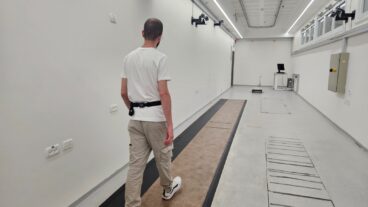Spacecom’s rapidly growing satellite fleet provides communication capabilities for many of the world’s highest-demand markets.

Many people are surprised to learn that Israel is among the world’s top communication satellite superpowers.
Israeli company Spacecom will launch the fourth in its AMOS satellite series this year, to be followed by the fifth in 2012, the sixth in 2014 and more to come.
The AMOS satellite fleet will provide coverage over many of the world’s fastest-growing and highest-demand satellite markets, including the Middle East, Central and Eastern Europe (CEE), Asia and Africa, and positions Spacecom as a multi-regional satellite operator reaching more than 80 percent of the world’s population.
Rapidly growing satellite market
Spacecom’s AMOS-3 and AMOS-2 satellites, located at Spacecom’s 4°W orbital spot, already provide multi-regional coverage.
“Our focus at 4°W has been CEE, certain parts of the Middle East and the US East Coast,” says Gil Ilany, vice president for marketing at Spacecom.
“We are readying the AMOS-6 satellite, scheduled for launch in 2014, for pan-European coverage, with extended bandwidth for broadband services and additional capacity for the Middle East,” he tells ISRAEL21c.
“We believe that the CEE markets continue to be very viable and growth will continue in the future. The Russian and Ukrainian markets, for instance, are growing rapidly. We also anticipate growth of the TV market in Africa and the upcoming launch of our AMOS-5 will provide a solution for that market.”
AMOS-2 and AMOS-3 provide direct-to-home (DTH) services, video distribution to cable head-ends, broadband Internet and VSAT — small dish antennas that enable satellite communication for banks and other institutions with global branches. They can also help telecommunications carriers extend their reach to rural areas lacking adequate ground infrastructure.
AMOS-5, scheduled to be launched later this year at the orbital location at 17°E, and AMOS-4, scheduled for liftoff in 2012 to a new orbital location at 65°E over the Indian Ocean, will provide fast communication services to enterprises with wide geographical reach in Africa and Asia, such as telecoms, cellular operators, banks, hospitals and government institutions.
Most advanced in the world
AMOS-4 is one of the most advanced satellites of its kind in the world, says Ilany. It has 10 antennas, which is unprecedented for a commercial satellite. Its unique resources allocation system will enable customers to lease capacity on the satellite and independently operate and manage it.
AMOS-5 will connect Africa with Europe and the Middle East. Its fixed pan-African C-band beam is impervious to weather conditions, and it has three steerable Ku-band beams that allow Spacecom to divert them from according to demand.
AMOS-5’s services will include DTH, VSAT, broadband Internet, telephony, data, video and cellular backhaul — the transmission of communication from one cellular antenna to another and between cellular antennas and the hub.
“Despite extensive infrastructure investments in fibers and Internet access in Africa and Asia, the need for high bandwidth increases further with the introduction of advanced, high-bandwidth consuming, services and video technologies such as HD and 3D,” says Ilany.
“Moreover, the growing need to provide efficient broadcast distribution and data services in rural areas stimulates the demand for satellite services with its wide coverage and rapid time to market.”
According to Ilany, the most pressing need in Asia is for video services. In addition, there are strong demands for data and broadband services.
Meeting high demand in Africa
Meanwhile, Africa has become one of the fastest-growing communications markets in the world.
“One of the most significant needs we see in Africa is for cellular backhaul satellite services,” says Ilany. “We also see a high need for Internet, video and VSAT networks. We expect the high demand for satellite communication in Africa to continue growing in the next few years.”
Eyal Copitt, Spacecom’s senior vice president of sales for Africa, says that during 2010 the company began pre-selling capacity to new customers and partners.
“AMOS-5 enables us to become a multi-regional satellite operator and positions Spacecom as an attractive source of C-band and Ku-band capacity for a variety of African and African-related businesses,” he tells ISRAEL21c.
Since 2010, more satellites provide communication services to Africa, and many new ventures added a great deal of fiber infrastructures.
“These developments, especially the addition of new fiber, create fertile ground to accelerate the wireless business in Africa,” says Copitt. “This trend results in enhanced communications speeds and quality, open broadband Internet for mass consumption and lowered barriers for enterprises to add Internet services.”
Possible military applications
AMOS-4 will provide services throughout Asia, the entire Middle East (from Israel in the west to Afghanistan and Pakistan in the east) as well as central, east and south Africa.
Ilany says that in addition to services for civilian and government institutions in these regions, AMOS-4 would be a good fit for the US army, currently the main user of the Ka-band frequencies range, thanks to its coverage of the entire Middle East with additional coverage in central Europe.
AMOS-4 would enable the Pentagon to communicate directly with army units in the Middle East, and to carry out numerous communications-based missions. For example, the Pentagon would be able to order a remote-piloted vehicle in the Middle East to take off and film certain areas, enabling US commanders on the ground to get the video clips in real time. It would also allow video conferencing between remote military leaders and soldiers in the desert, in addition to other real-time applications.












